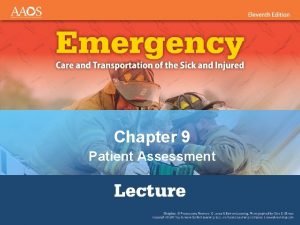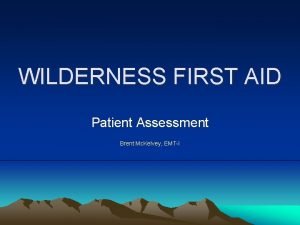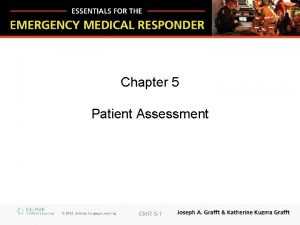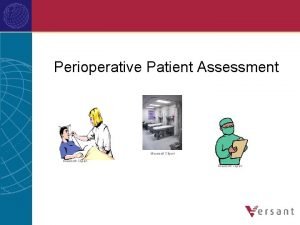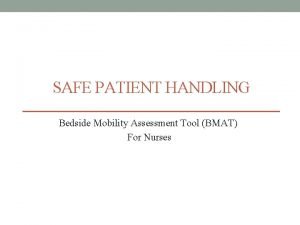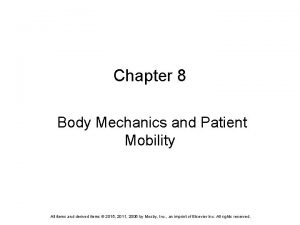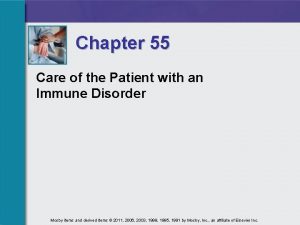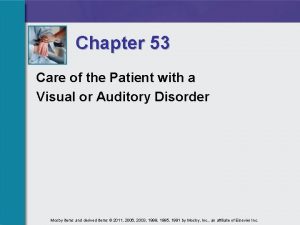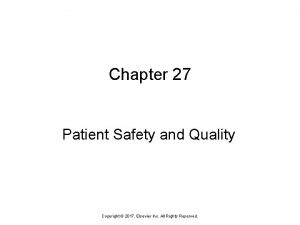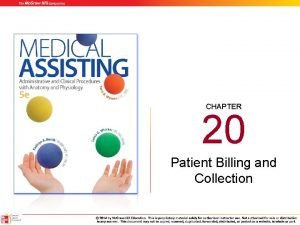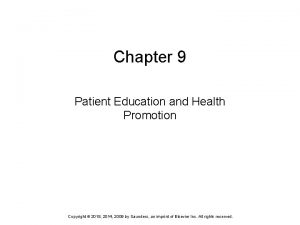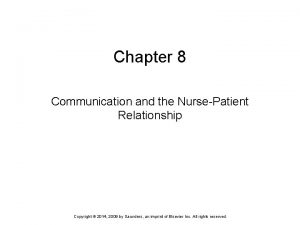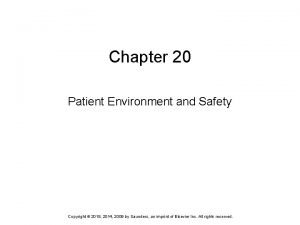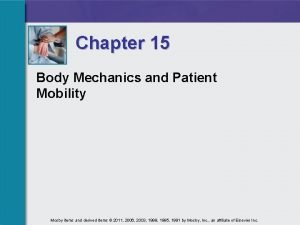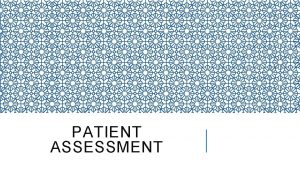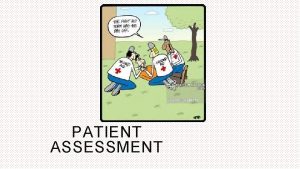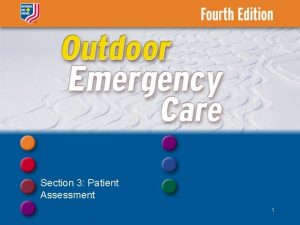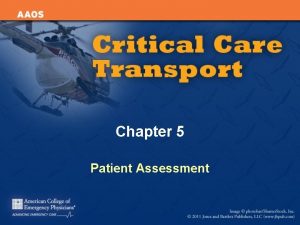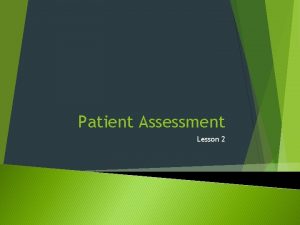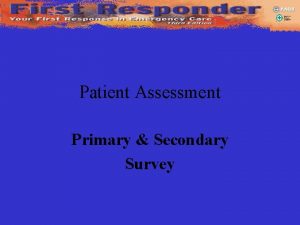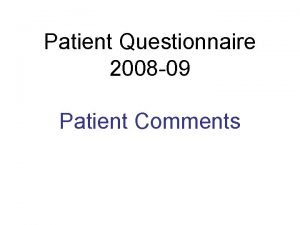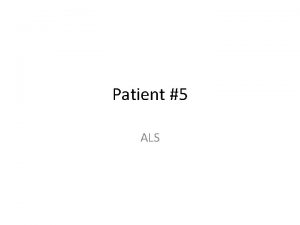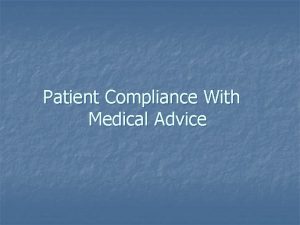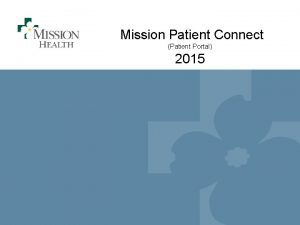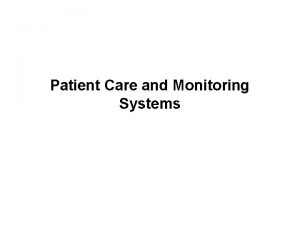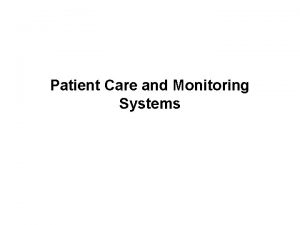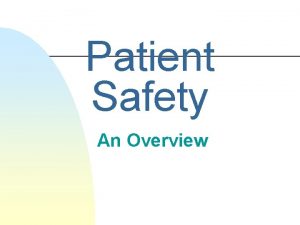Section 3 Patient Assessment Chapter 8 Patient Assessment













































































- Slides: 77

Section 3: Patient Assessment

Chapter 8 Patient Assessment

3: Patient Assessment Objectives (1 of 9) • • • Scene Size-up Describe the importance of recognizing potential hazards Describe common hazards found at the scene Determine if the scene is safe to enter Discuss identifying the number of patients at the scene Explain the need for additional help or assistance Emergency Care and Transportation of the Sick and 3

3: Patient Assessment Objectives (2 of 9) • • • Initial Assessment Summarize the reasons forming a general impression Discuss methods of assessing altered mental status Discuss methods of assessing the airway State reasons for managing the cervical spine Discuss methods for assessing if a patient is breathing Emergency Care and Transportation of the Sick and 4

3: Patient Assessment Objectives (3 of 9) • State what care should be provided to a patient with adequate breathing • State what care should be provided to a patient without adequate breathing • Describe methods used to obtain a pulse • Discuss the need for assessing for external bleeding Emergency Care and Transportation of the Sick and 5

3: Patient Assessment Objectives (4 of 9) • Describe normal and abnormal findings when assessing skin color • Describe normal and abnormal findings when assessing skin temperature • Describe normal and abnormal findings when assessing skin condition • Describe normal and abnormal findings when assessing capillary refill • Explain the reason for prioritizing a patient for care and transport Emergency Care and Transportation of the Sick and 6

3: Patient Assessment Objectives (5 of 9) Focused History and Physical Exam: Trauma • Discuss reasons for reconsidering the MOI • State the reasons for performing a rapid trauma assessment • Describe the rapid trauma assessment and what should be evaluated • Differentiate when the rapid assessment may be altered to provide patient care Emergency Care and Transportation of the Sick and 7

3: Patient Assessment Objectives (6 of 9) Focused History and Physical Exam: Medical Patients • Describe the need for assessing a patient with a specific complaint and no known history • Differentiate between the assessment for responsive patients without a history and responsive patients with a history Emergency Care and Transportation of the Sick and 8

3: Patient Assessment Objectives (7 of 9) • Describe the unique needs of assessing an unresponsive patient • Differentiate between the assessment performed on an unresponsive patient and other medical patients Emergency Care and Transportation of the Sick and 9

3: Patient Assessment Objectives (8 of 9) Detailed Physical Exam • Discuss components of the detailed physical exam • Explain what additional care is provided during the detailed physical exam • Distinguish between the detailed exam on a trauma and medical patient Emergency Care and Transportation of the Sick and 10

3: Patient Assessment Objectives (9 of 9) Ongoing Assessment • Discuss the reason for repeating the initial assessment • Describe the components of the ongoing assessment • Describe trending of assessment components Emergency Care and Transportation of the Sick and 11

3: Patient Assessment Process • Scene size-up • Initial assessment • Provide spinal immobilization • Identify and treat life threats • Focused history and physical exam • Provide transport if needed • Detailed physical exam • Reassess vital signs • Ongoing assessment Emergency Care and Transportation of the Sick and 12

3: Patient Assessment The Patient Assessment Process Emergency Care and Transportation of the Sick and 13

3: Patient Assessment Body Substance Isolation • Assumes all body fluids present a possible risk for infection • Protective equipment • Latex or vinyl gloves should always be worn • Eye protection • Mask • Gown Emergency Care and Transportation of the Sick and 14

3: Patient Assessment Scene Safety Potential Hazards • • Oncoming traffic Unstable surfaces Leaking gasoline Downed electrical lines • Potential for violence • Fire or smoke • Hazardous materials • Other dangers at crash or rescue scenes • Crime scenes Emergency Care and Transportation of the Sick and 15

3: Patient Assessment Scene Safety • Park in a safe area • Speak with law enforcement first if present. • The safety of you and your partner comes first! • Next concern is the safety of patient(s) and bystanders. • Request additional resources if needed to make scene safe. Emergency Care and Transportation of the Sick and 16

3: Patient Assessment Mechanism of Injury • Helps determine the possible extent of injuries on trauma patients • Evaluate: • Amount of force applied to body • Length of time force was applied • Area of the body involved Emergency Care and Transportation of the Sick and 17

3: Patient Assessment Motor Vehicle Crashes • Amount of force related to speed • Injuries can be predicted by: • Position in the car • Use of seat belts • How the body shifts during the crash Emergency Care and Transportation of the Sick and 18

3: Patient Assessment Falls • Amount of force related to height of fall • Note surface that patient landed on • Attempt to determine how patient landed Emergency Care and Transportation of the Sick and 19

3: Patient Assessment Gunshot and Stab Wounds • Gunshot wounds • Force is related to caliber of weapon and distance from gun to the patient • Stab wounds • Injury can be estimated by looking at the entrance and length of the weapon Emergency Care and Transportation of the Sick and 20

3: Patient Assessment Nature of Illness • Search for clues to determine the nature of illness. • Often described by the patient’s chief complaint • Gather information from the patient and people on scene. • Observe the scene. Emergency Care and Transportation of the Sick and 21

3: Patient Assessment Number of Patients • Determine the number of patients and their condition. • Assess what additional resources will be needed. • Triage to identify severity of each patient’s condition. Emergency Care and Transportation of the Sick and 22

3: Patient Assessment Process Emergency Care and Transportation of the Sick and 23

3: Patient Assessment Components of the Initial Assessment • • Develop a general impression Assess mental status Assess airway Assess the adequacy of breathing • Assess circulation • Identify patient priority Emergency Care and Transportation of the Sick and 24

3: Patient Assessment Develop a General Impression • Occurs as you approach the scene and the patient • Assessment of the environment • Patient’s chief complaint • Presenting signs and symptoms of patient Emergency Care and Transportation of the Sick and 25

3: Patient Assessment Distinguishing Between Medical and Trauma • Determination should come after assessment is finished. • Patients may have traumatic injuries caused by a medical reason. • Initially assume all patients have both medical and traumatic aspects to their condition. Emergency Care and Transportation of the Sick and 26

3: Patient Assessment Assessing Mental Status • Checking responsiveness • Assess how well the patient responds to external stimuli. • Check for orientation • Check the patient’s memory to person, place, time, and event. If he or she recalls all four, then he or she is fully alert and oriented times four. Emergency Care and Transportation of the Sick and 27

3: Patient Assessment Level of Consciousness • A Alert • V Responsive to Verbal stimulus • P Responsive to Pain • U Unresponsive Emergency Care and Transportation of the Sick and 28

3: Patient Assessment Assessing the Airway • Look for signs of airway compromise: • Two- to three-word dyspnea • Use of accessory muscles • Nasal flaring and use of accessory muscles in children • Labored breathing Emergency Care and Transportation of the Sick and 29

3: Patient Assessment Signs of Airway Obstruction in the Unconscious Patient • Obvious trauma, blood, or other obstruction • Noisy breathing such as bubbling, gurgling, crowing, or other abnormal sounds • Extremely shallow or absent breathing Emergency Care and Transportation of the Sick and 30

3: Patient Assessment Assessing Breathing • Are the patient’s respirations shallow or deep? • Does the patient appear to be choking? • Is the patient cyanotic (blue)? • Is the patient moving air into and out of the lungs as the chest rises and falls? Emergency Care and Transportation of the Sick and 31

3: Patient Assessment Managing Breathing • If patient is having difficulty breathing reevaluate airway. • Consider assisting ventilations with a BVM or applying a nonrebreathing mask if patient’s respirations are greater than 24/min or less than 8/min. Emergency Care and Transportation of the Sick and 32

3: Patient Assessment Unresponsive Patients • Look, listen and feel technique • Consider spinal cord injury. • Provide high-flow oxygen. • Assist ventilations if needed. Emergency Care and Transportation of the Sick and 33

3: Patient Assessment Assessing Circulation (1 of 2) • Assess the pulse. • Rate, rhythm and strength • Assess and control external bleeding. • Direct pressure • Evaluate skin color. • Cyanotic, flushed, pale or jaundiced Emergency Care and Transportation of the Sick and 34

3: Patient Assessment Assessing Circulation (2 of 2) • Evaluate skin temperature. • Skin is an organ. • Evaluate skin condition. • Dry or moist • Evaluate capillary refill. • Should be less than 2 seconds Emergency Care and Transportation of the Sick and 35

3: Patient Assessment Restoring Circulation • Control bleeding and improve oxygen delivery. • If unresponsive and pulseless begin CPR. • Apply and operate the AED as quickly as possible. • Do not use AED on patients with a catastrophic traumatic injury. Emergency Care and Transportation of the Sick and 36

3: Patient Assessment Identifying Priority Patients • Poor general impression • Unresponsive with no gag or cough reflexes • Difficulty breathing • Signs of poor perfusion • Complicated childbirth • Uncontrolled bleeding • Severe pain • Severe chest pain • Inability to move any part of the body Emergency Care and Transportation of the Sick and 37

3: Patient Assessment Process Emergency Care and Transportation of the Sick and 38

3: Patient Assessment Goals of Exam • Identify the patient’s chief complaint. • Understand the specific circumstances surrounding the chief complaint. • Direct further physical examination. Emergency Care and Transportation of the Sick and 39

3: Patient Assessment The Golden Hour Emergency Care and Transportation of the Sick and 40

3: Patient Assessment Significant Mechanism of Injury • Ejection from vehicle • Death in passenger compartment • Fall greater than 15´ 20´ • Vehicle rollover • High-speed collision • Vehicle-pedestrian collision • Motorcycle crash • Unresponsiveness or altered mental status • Penetrating trauma to head, chest, or abdomen Emergency Care and Transportation of the Sick and 41

3: Patient Assessment Significant Mechanism of Injury for Children • Includes the list from the previous slide as well as: • Fall greater than 2 to 3 times their height • Bicycle crash Emergency Care and Transportation of the Sick and 42

3: Patient Assessment Hidden Injuries • Seat belts • May cause injuries if worn improperly • Airbags • Look beneath airbag for bent steering wheel. Emergency Care and Transportation of the Sick and 43

3: Patient Assessment Trauma Assessment • D Deformities • B Burns • C Contusions • T Tenderness • A Abrasions • L Lacerations • P Punctures/ Penetrations • S Swelling Emergency Care and Transportation of the Sick and 44

3: Patient Assessment Rapid Trauma Assessment (1 of 3) • Maintain spinal immobilization while checking patient’s ABCs. • Assess the head. • Assess the neck. • Apply a cervical spine immobilization collar. Emergency Care and Transportation of the Sick and 45

3: Patient Assessment Rapid Trauma Assessment (2 of 3) • Assess the chest. • Assess the abdomen. • Assess the pelvis. • Assess all four extremities. Emergency Care and Transportation of the Sick and 46

3: Patient Assessment Rapid Trauma Assessment (3 of 3) • Roll the patient with spinal precautions. • Assess baseline vital signs and SAMPLE history. Emergency Care and Transportation of the Sick and 47

3: Patient Assessment Head, Neck, and Cervical Spine • Feel head and neck for deformity, tenderness, or crepitation. • Check for bleeding. • Ask about pain or tenderness. Emergency Care and Transportation of the Sick and 48

3: Patient Assessment Chest • Watch chest rise and fall with breathing. • Feel for grating bones as patient breathes. • Listen to breath sounds. Emergency Care and Transportation of the Sick and 49

3: Patient Assessment Abdomen • Look for obvious injury, bruises, or bleeding. • Evaluate for tenderness and any bleeding. • Do not palpate too hard. Emergency Care and Transportation of the Sick and 50

3: Patient Assessment Pelvis • Look for any signs of obvious injury, bleeding, or deformity. • Press gently inward and downward on pelvic bones. Emergency Care and Transportation of the Sick and 51

3: Patient Assessment Extremities • Look for obvious injuries. • Feel for deformities. • Assess • Pulse • Motor function • Sensory function Emergency Care and Transportation of the Sick and 52

3: Patient Assessment Back • Feel for tenderness, deformity, and open wounds. • Carefully palpate from neck to pelvis. • Look for obvious injuries. Emergency Care and Transportation of the Sick and 53

3: Patient Assessment Vital Signs • After rapid assessment, obtain baseline vital signs and a SAMPLE history. • Vital signs of stable patients should be reassessed every 15 minutes. • Vital signs of unstable patients should be reassessed every 5 minutes. Emergency Care and Transportation of the Sick and 54

3: Patient Assessment SAMPLE History • S Signs and symptoms • A Allergies • M Medications • P Past medical history • L Last oral intake • E Events leading to the episode Emergency Care and Transportation of the Sick and 55

3: Patient Assessment Focused History and Physical Exam • Assess the chief complaint. • Chest pain • Shortness of breath • Abdominal pain • Any pain associated with bones or joints • Dizziness • Obtain baseline vital signs and SAMPLE history Emergency Care and Transportation of the Sick and 56

3: Patient Assessment Documentation • Skin color, temperature, and moisture • Initial assessment findings • Baseline and subsequent vital signs and SAMPLE history • Circulation, sensation and movement in all extremities • Breath sounds Emergency Care and Transportation of the Sick and 57

3: Patient Assessment Other Considerations • The following patients should receive a rapid trauma assessment and immediate transport • Significant mechanism of injury • Unresponsive or disoriented • Extremely intoxicated • Patients whose complaint cannot be identified or understood Emergency Care and Transportation of the Sick and 58

3: Patient Assessment Process Emergency Care and Transportation of the Sick and 59

3: Patient Assessment Assessing the Responsive Patient • Ask general questions to find out the chief complaint. • Listen to the patient. • Record the chief complaint in a few of the patient’s words. • Use OPQRST to gather history of present illness. Emergency Care and Transportation of the Sick and 60

3: Patient Assessment OPQRST (1 of 2) • O Onset • When did the problem first start? • P Provoking factors • What creates or makes the problem worse? • Q Quality of pain • Description of the pain Emergency Care and Transportation of the Sick and 61

3: Patient Assessment OPQRST (2 of 2) • R • • S • • T • Radiation of pain or discomfort Does the pain radiate anywhere? Severity Intensity of pain on 1 -to-10 scale Time How long has the patient had this problem? Emergency Care and Transportation of the Sick and 62

3: Patient Assessment SAMPLE History • Questions to ask: • Have you ever been told you have a heart condition? • Have you ever been told you have problems with your lungs? • Have you ever been told you have seizures? Emergency Care and Transportation of the Sick and 63

3: Patient Assessment Focused Physical Exam • Investigate problems associated with chief complaint. • Examine abnormalities. • Reassess vital signs. • Make transportation decision. • Document findings. Emergency Care and Transportation of the Sick and 64

3: Patient Assessment Assessing the Unresponsive Patient • Perform a rapid medical assessment. • Obtain baseline vital signs. • Obtain SAMPLE history from family if available. • Provide emergency care and transport. • Document findings. Emergency Care and Transportation of the Sick and 65

3: Patient Assessment Process Emergency Care and Transportation of the Sick and 66

3: Patient Assessment Detailed Physical Exam • More in-depth exam based on focused physical exam • Should only be performed if time and patient’s condition allows • Usually performed en route to the hospital Emergency Care and Transportation of the Sick and 67

3: Patient Assessment Performing the Detailed Physical Exam (1 of 5) • Visualize and palpate using DCAP-BTLS. • Look at the face. • Inspect the area around the eyes and eyelids. • Examine the eyes. • Pull the patient’s ear forward to assess for bruising. Emergency Care and Transportation of the Sick and 68

3: Patient Assessment Performing the Detailed Physical Exam (2 of 5) • Use the penlight to look for drainage or blood in the ears. • Look for bruising and lacerations about the head. • Palpate the zygomas. • Palpate the maxillae. • Palpate the mandible. Emergency Care and Transportation of the Sick and 69

3: Patient Assessment Performing the Detailed Physical Exam (3 of 5) • Assess the mouth for obstructions and cyanosis. • Check for unusual odors. • Look at the neck. • Palpate the front and the back of the neck. • Look for distended jugular veins. Emergency Care and Transportation of the Sick and 70

3: Patient Assessment Performing the Detailed Physical Exam (4 of 5) • • Look at the chest. Gently palpate over the ribs. Listen for breath sounds. Listen also at the bases and apices of the lungs. • Look at the abdomen and pelvis. Emergency Care and Transportation of the Sick and 71

3: Patient Assessment Performing the Detailed Physical Exam (5 of 5) • • • Gently palpate the abdomen. Gently compress the pelvis. Gently press the iliac crests. Inspect all four extremities. Assess the back for tenderness or deformities. Emergency Care and Transportation of the Sick and 72

3: Patient Assessment Process Emergency Care and Transportation of the Sick and 73

3: Patient Assessment Ongoing Assessment • Is treatment improving the patient’s condition? • Has an already identified problem gotten better? Worse? • What is the nature of any newly identified problems? Emergency Care and Transportation of the Sick and 74

3: Patient Assessment Steps of the Ongoing Assessment • Repeat the initial assessment. • Reassess and record vital signs. • Repeat focused assessment. • Check interventions. Emergency Care and Transportation of the Sick and 75

3: Patient Assessment Review Emergency Care and Transportation of the Sick and 76

3: Patient Assessment The Communication Process • Do what you can to make the patient comfortable. • Listen to the patient. • Make eye contact. • Base questions on the patient's complaint. • Mentally summarize before starting treatment. Emergency Care and Transportation of the Sick and 77
 Chapter 9 patient assessment
Chapter 9 patient assessment Patient 2 patient
Patient 2 patient Study guide chapter 10 section 1 meiosis
Study guide chapter 10 section 1 meiosis Chapter 2 section 4 modern economies worksheet answers
Chapter 2 section 4 modern economies worksheet answers First aid patient assessment form
First aid patient assessment form Emr patient assessment
Emr patient assessment Kleinman and campbell patient explanatory assessment model
Kleinman and campbell patient explanatory assessment model Opqrst sample
Opqrst sample Critical clipart
Critical clipart Bedside mobility assessment tool
Bedside mobility assessment tool Assessment of patient
Assessment of patient Chapter 10 chemical reactions answer key
Chapter 10 chemical reactions answer key Chapter 11 stoichiometry test
Chapter 11 stoichiometry test Chapter 9 chemical reactions answers
Chapter 9 chemical reactions answers Chapter 9 surface water answer key
Chapter 9 surface water answer key Representing motion physics
Representing motion physics Chemistry the central science 14th edition
Chemistry the central science 14th edition Chapter 2 standardized test practice answers
Chapter 2 standardized test practice answers Ionic compounds
Ionic compounds Chapter 7 chapter assessment ionic compounds and metals
Chapter 7 chapter assessment ionic compounds and metals Csm neurovascular assessment
Csm neurovascular assessment Chapter 55 care of the patient with an immune disorder
Chapter 55 care of the patient with an immune disorder Chapter 53 care of the patient with a sensory disorder
Chapter 53 care of the patient with a sensory disorder Chapter 27 patient safety and quality
Chapter 27 patient safety and quality The process of classifying and reviewing past due accounts
The process of classifying and reviewing past due accounts Chapter 9 patient education and health promotion
Chapter 9 patient education and health promotion Therapeutic communication techniques
Therapeutic communication techniques Patient environment and safety
Patient environment and safety Chapter 8 body mechanics and patient mobility
Chapter 8 body mechanics and patient mobility Half section view example
Half section view example Example of revolved section
Example of revolved section Partial section view
Partial section view Section 1 work and machines section 2 describing energy
Section 1 work and machines section 2 describing energy Section 3 assessment
Section 3 assessment Features and principles of portfolio assessment
Features and principles of portfolio assessment Static assessment vs dynamic assessment
Static assessment vs dynamic assessment Portfolio assessment matches assessment to teaching
Portfolio assessment matches assessment to teaching Chapter 17 section 3 world history
Chapter 17 section 3 world history Chapter 30 section 2 world history
Chapter 30 section 2 world history What was the counter-reformation?
What was the counter-reformation? Chapter 10 section 2 central america and the caribbean
Chapter 10 section 2 central america and the caribbean Chapter 14 section 1 work and power
Chapter 14 section 1 work and power Chapter 19 section 4 wilson fights for peace
Chapter 19 section 4 wilson fights for peace Chapter 15 section 1 types of waves answers
Chapter 15 section 1 types of waves answers Chapter 24 section 2 watergate answers
Chapter 24 section 2 watergate answers Chapter 11 section 4 using water wisely answer key
Chapter 11 section 4 using water wisely answer key We think we are using water wisely because
We think we are using water wisely because Chapter 6 section 1 combining supply and demand answers
Chapter 6 section 1 combining supply and demand answers Examples of economic protest parties
Examples of economic protest parties Turmoil and change in mexico
Turmoil and change in mexico Chapter 14 section 2 totalitarianism
Chapter 14 section 2 totalitarianism Chapter 22 section 5 the end of the war and its legacy
Chapter 22 section 5 the end of the war and its legacy Chapter 19 section 1 the unalienable rights
Chapter 19 section 1 the unalienable rights Chapter 5 section 2 the supply curve shifts
Chapter 5 section 2 the supply curve shifts Chapter 18 section 4 the special courts
Chapter 18 section 4 the special courts Valeriano butcher weyler
Valeriano butcher weyler Chapter 11 section 1 the scramble for africa
Chapter 11 section 1 the scramble for africa The scramble for africa chapter 27 section 1 answers
The scramble for africa chapter 27 section 1 answers Chapter 6 the scientific revolution
Chapter 6 the scientific revolution Chapter 10 section 1 the rise of islam
Chapter 10 section 1 the rise of islam The rise of islam chapter 10 section 1
The rise of islam chapter 10 section 1 Chapter 6 section 3 guided reading the rise of christianity
Chapter 6 section 3 guided reading the rise of christianity Chapter 21 section 2 the reign of louis xiv
Chapter 21 section 2 the reign of louis xiv Chapter 17 section 4 the reformation continues
Chapter 17 section 4 the reformation continues Chapter 13 section 4 the power of the church
Chapter 13 section 4 the power of the church Chapter 12 section 1 the politics of reconstruction
Chapter 12 section 1 the politics of reconstruction Northern renaissance literature
Northern renaissance literature Chapter 11 section 2 the north transformed
Chapter 11 section 2 the north transformed Chapter 24 section 1 the nixon administration answers
Chapter 24 section 1 the nixon administration answers Chapter 32 section 1 the nixon administration
Chapter 32 section 1 the nixon administration Chapter 32 section 1 the nixon administration
Chapter 32 section 1 the nixon administration The new frontier chapter 20 section 2
The new frontier chapter 20 section 2 New deal affects many groups
New deal affects many groups Chapter 18 section 3 the mughal empire in india
Chapter 18 section 3 the mughal empire in india Chapter 10 section 4 the members of congress
Chapter 10 section 4 the members of congress The mandt system chapter 1 2 3- relational section answers
The mandt system chapter 1 2 3- relational section answers Chapter 24 the land where continents collided answer key
Chapter 24 the land where continents collided answer key Chapter 12 section 2 the harding presidency
Chapter 12 section 2 the harding presidency
